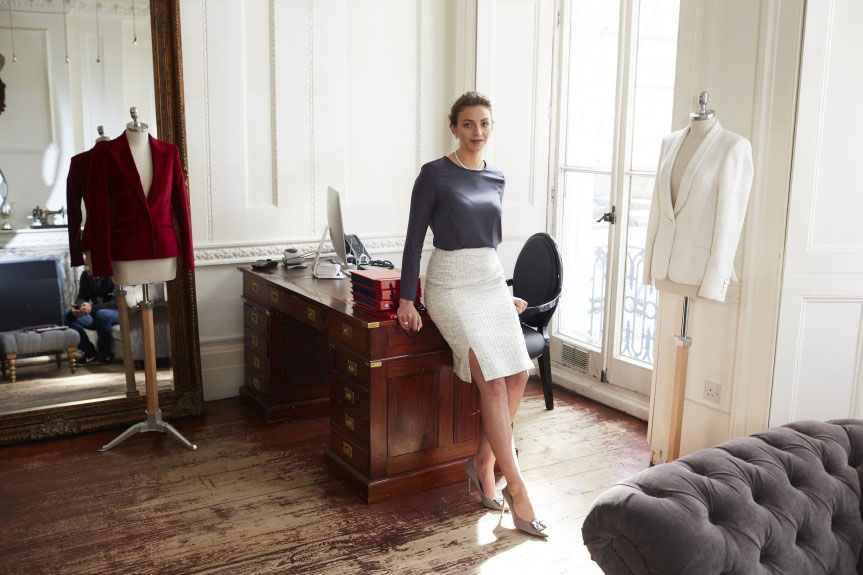
Gormley and Gamble
Founder, Phoebe Gormley
26.10.17
Established in 2015, to re-define the classics, beautifully, elegantly and simply by women for women, Gormley and Gamble are the first women-only tailors in the history of Savile Row.
What have been the main contributors to your brands success?
Breaking the mould in a totally male-dominated environment, and, if I may say so – making history being the first womenswear store in Savile Row’s history.
At what point did the idea turn from a concept into a reality?
When I was 20, I had dropped out of university and moved to London with £9,000 of unspent tuition fees and a dream.
What are the current trends in the marketplace and do you see these changing anytime soon?
Like I said; experience. A great example of this is personalisation – whether that’s having a jacket from me and watching your initials being stitched in, or going to Anya Hindmarch and mix and matching all the elements of your bag, or if it’s Sweaty Betty’s yoga classes, or using Inkpact to write hand-written letters to customers instead of throwaway emails. Customers are becoming savvy and they want to be treated like humans, not valued email addresses.
Another trend I think is going to be huge is being socially conscious. We are already starting to see the rise of ideas like H&M Conscious, as well as whole stores solely devoted to sustainability like theAcey.com. Consumers aren’t buying battery-farmed chicken anymore, they’re shopping in Planet Organic and Ocado. People want to know that what they’re ordering, a) hasn’t done more air-miles than them in the last year, b) isn’t exploiting someone (usually a woman, who is choosing between poverty or slave labour) and c) isn’t made from a fabric that is destroying the environment.
Where have your biggest influences come from?
My Dad – for being a just-take-a-leap-of-faith businessman, who risked it all. Meg Lustman, CEO of Hobbs, for showing me exactly what a guardian angel looks like in a mentoring form. Donna Ida Thornton, for being the hardest working person I have ever met.
Your one piece of advice for anyone considering starting a high-end fashion brand?
Do you like sleep? If so, don’t do it.
Joking. Half joking. My advice would be; the market is saturated, what’s your USP? Not the fluffy USP that you think is enough, a genuine USP that sets you apart? Refine your idea until you have it.
The product is beautifully designed how do you ensure consistency as you grow the brand?
I have a great team with a fantastic eye for detail, nothing gets past them.
What future challenges and developments do you foresee in the retail industry?
There is so much exciting opportunity with the advancements of technology to create out-of-this-world shopping experiences. I am not a big online shopper and personally love being in a store. I think we will see online stores needing a retail presence (like Amazon’s book shop and Net A Porter’s store in the UAE) to create that exception EXPERIENCE, which I think is the buzz word that brands are focusing on in the future. Think of the Apple Packaging. If that came in a plastic bag, it wouldn’t be special, but the thrill of unpacking those white boxes, it sets a tone; an experience. I don’t believe online can match the multi-sensory experience that a store can.
In terms of challenges, as a small business, I think the challenges are competing for floor space in a market dominated by the likes of LVH which can afford ludicrous rents, and risks pricing us out to the extent where small businesses are going to really struggle to reach a ‘medium size’ without some help.
Which areas in London do you feel will experience a surge in interesting new retailers?
I think we’re seeing places outside zone 1 reach new interest. For Londoners – weekends are sacred, and coming into Central London on a Saturday or Sunday can often just be a touristy nightmare. People are spending time around their homes, investing in their neighbourhoods, aiming to improve their local environment and have a symbiotic relationship of investing locally, and their quality of life improving as more small businesses open up around them. A great example of this is around Victoria Park in Hackney, with Columbia Road flower market attracting locals, you can see the area becoming more and more exciting as it gentrifies and independent businesses can afford to set up shop.